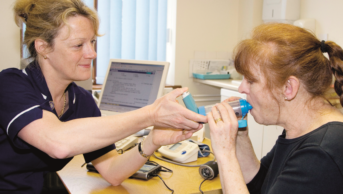
Oxford University Images / Science Photo Library
A study of 3,660 patients across eight countries has identified the types of inhaler technique errors that are associated with the greatest impact on asthma outcomes.
For metered-dose inhalers (MDI), researchers found that important factors relating to errors included the coordination and positioning of people’s bodies, such as not having their chin in the right orientation. For dry powder inhalers (DPI), the most critical factors related to breathing errors were not breathing out before inhaling, and not breathing in hard and fast enough.
“The value of [our] study is that we didn’t find new inhaler errors — we found which ones are really important,” says lead author David Price, chair of primary care respiratory medicine at the University of Aberdeen. “Some of the errors people thought were critical didn’t turn out to be critical in real life.”
The researchers say the results indicate that targeting these key errors during inhaler training could improve asthma outcomes.
“The findings tell pharmacists and healthcare professionals which areas are important to focus on,” Price adds.
The research involved 3,660 patients taking part in iHARP (initiative Helping Asthma in Real-life Patients) — a cross-sectional study that collected data on asthma patients in eight different countries between 2011 and 2014.
Patients’ inhaler technique was observed by trained medical professionals and recorded against a predefined checklist. Asthma control was assessed via questionnaire and exacerbations over the previous 12 months were recorded if patients had an emergency attendance at hospital, hospital admission for breathing or chest problems, or had a course of oral steroids for worsening asthma.
The observational study involved two cohorts of patients using a DPI (Symbicort Turbohaler, n=2,074 or Seretide Diskus, n=826) and one using an MDI (Seretide MDI, n=760).
The researchers found that insufficient inspiratory effort was a common error for patients using a DPI, and was recorded in 32%–38% of patients. This error was associated with a 30% increased risk of uncontrolled asthma in those using a Turbohaler and a 56% increased risk in those using a Diskus device (adjusted odds ratios 1.30, 95% confidence interval [CI] 1.08–1.57, and 1.56, 95% CI 1.17–2.07, respectively). The rate of exacerbations was also increased for both devices when patients made this error.
However, failure to breathe out to empty the lungs before inhalation was not associated with uncontrolled asthma, despite being demonstrated by around a quarter of patients.
For MDIs, actuation before inhalation was associated with a 55% increased risk of uncontrolled asthma (adjusted odds ratio 1.55, 95% CI 1.11-2.16). But the most frequent error — inspiratory effort not being slow and deep enough — was not associated with uncontrolled asthma. And none of the identified errors were significantly associated with exacerbation rate in MDI users in adjusted analyses.
Other specific errors linked to poor outcomes include: failure to remove the cap and the dosage being compromised after the device was shaken or tipped, which were significantly associated with uncontrolled asthma for Turbohaler users; and not tilting the chin upwards, which was linked to uncontrolled asthma in MDI users.
Reporting their findings in the Journal of Allergy and Clinical Immunology In Practice
[1]
(online, 9 March 2017), the researchers say this is the first study to look at the influence of individual, specific errors on poor asthma outcomes.
Price says that, as there are many new inhalers on the market, future research should look at which errors are important for these devices.
Commenting on the study, Anna Murphy, consultant respiratory pharmacist at University Hospitals of Leicester NHS Trust, says that the research underlines the importance of individualised care for asthma patients. “This is an important study and adds to the increasing evidence that overwhelmingly supports optimising a patient’s inhaler technique and ensuring the person is prescribed a device that they can use.”
Murphy adds that there are many things that pharmacists can do to help patients use their inhalers better, including observing their inhaler technique and following up on their technique regularly.
It is really important for pharmacists to acknowledge that optimal inhaler technique is fundamental for asthma treatments to work, she says.
“This method of administration of medicine needs to be taken seriously,” she says. “If we, as healthcare professionals, see the inhaler as important and that correct administration is vital, it will not only help the patient clinically, reduce adverse side effects and associated NHS costs, it may also help patients with long-term adherence to their treatment regimes.”
References
[1] Price DB, Román-RodrÃguez M, McQueen RB et al. Inhaler errors in the CRITIKAL Study: type, frequency, and association with asthma outcomes. Journal of Allergy and Clinical Immunology In Practice 2017. doi: 10.1016/j.jaip.2017.01.004


